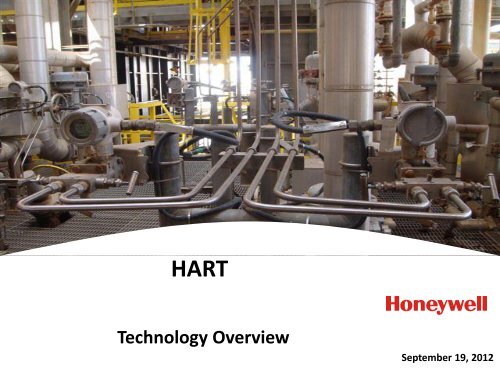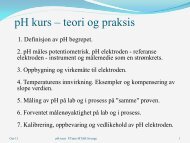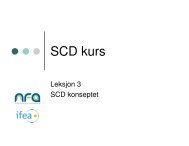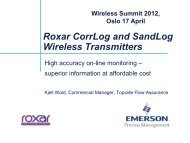HART Commands - Ifea
HART Commands - Ifea
HART Commands - Ifea
Create successful ePaper yourself
Turn your PDF publications into a flip-book with our unique Google optimized e-Paper software.
<strong>HART</strong><br />
Technology Overview<br />
September 19, 2012
<strong>HART</strong> Topics<br />
Hart Basics<br />
Hart Communication<br />
Hart Benefits<br />
Hart Usage in DCS<br />
2 HONEYWELL September 19, 2012
The <strong>HART</strong> Message<br />
<strong>HART</strong> is:<br />
� Simple!<br />
� Easy!<br />
� Inexpensive!<br />
� Feature Rich!<br />
Some Additional Benefits:<br />
For:<br />
� The <strong>HART</strong> Device Vendor<br />
� The Control System Vendor<br />
� The End User<br />
+ Ability to select from a wide range of device types and manufacturers!<br />
+ A very large installed base!<br />
3 HONEYWELL September 19, 2012<br />
3
<strong>HART</strong> Foundation Registered Devices<br />
There are over (990) devices from (238) different device vendors:<br />
Including the following device types:<br />
• Pressure<br />
• Flow<br />
• Level<br />
• Density<br />
• Temperature<br />
• Analyzers<br />
• Analytical devices<br />
• Positioners<br />
See WWW.hartcomm.ORG for the latest product listings<br />
4 HONEYWELL 4<br />
September 19, 2012
<strong>HART</strong> Device Information<br />
4-20 mA Analog Signal:<br />
The primary control signal is a standard 4-20 mA (0-100%) signal.<br />
<strong>HART</strong> Digital Data:<br />
In addition to the 4-20 mA signal, each <strong>HART</strong> field device maintains a<br />
database of information.<br />
Major data types maintained in device memory:<br />
� Device ID information (Tag, manufacturer, model, SN, etc.)<br />
� Software and hardware revision level<br />
� Dynamic variables (PV, SV, TV, and FV)<br />
� Device variables (Slot-0, Slot-1, Slot-2, and Slot-3)<br />
� General and device-specific status information<br />
� Range related information<br />
� Full device setup and configuration information<br />
� Trends and test analysis data<br />
Notice!<br />
You must check with each <strong>HART</strong> device vendor to determine what data is<br />
available in a given device type and revision.<br />
5 HONEYWELL September 19, 2012<br />
5
DD-POP Tool and <strong>HART</strong> Device Templates<br />
Honeywell:<br />
DD for:<br />
ST3000 transmitter<br />
Version 0202<br />
Experion PKS:<br />
<strong>HART</strong> DD-POP Tool<br />
Device Template:<br />
ST3000_0202<br />
Now appears as a selection in<br />
Control Builder.<br />
There must be a match between the actual Transmitter (Device) Revision<br />
number and the first two digits of DD revision number!<br />
Example:<br />
If the Transmitter (Device) revision = 02<br />
Then this xmtr can be used with any DD that begins with an 02 (DD 02xx, the<br />
xx number does not matter)<br />
6 HONEYWELL September 19, 2012<br />
6
<strong>HART</strong> Communication Protocol Features<br />
<strong>HART</strong> Version<br />
Feature 7 6 5<br />
Analog Loop Check � � �<br />
Broadcast Message � � �<br />
Device Calibration � � �<br />
Device Configuration � � �<br />
Device Status � � �<br />
Multi-Variable Reads � � �<br />
PV with Status � � �<br />
32 Character Tag � �<br />
All Variables with Status � �<br />
Digital Loop Check � �<br />
Enhanced Multi-Variable Support � �<br />
Local Interface Lock � �<br />
Manual ID of Device by Host � �<br />
Peer-to-peer Messages � �<br />
Visual ID of Device � �<br />
Time or Condition-based Alerts �<br />
Report by Exception �<br />
Synchronized Sampling �<br />
Time Stamp �<br />
Trends �<br />
Wireless Co-existance �<br />
Wireless Diagnostics �<br />
Wireless Mesh and Star Topologies �<br />
Wireless Message Routing �<br />
Wireless Security �<br />
<strong>HART</strong> 7 – Key Features<br />
• Enhanced Data Publishing<br />
- Support for Publish by Exception<br />
- Automatic Event Notification<br />
• Time Stamped Data<br />
- Know when the measurement was made.<br />
- Improves signal processing and control<br />
• Time-triggered Actions,<br />
Measurements<br />
- Measurements or actions can be triggered at<br />
specified time<br />
- Allows synchronized operation across multiple<br />
devices<br />
• Process Variable Trends<br />
- Multiple sequential data points of same process<br />
variable in one packet.<br />
• Command Aggregation<br />
- Multiple read commands in one transaction for<br />
faster configuration uploads<br />
• Wireless<strong>HART</strong> <br />
- Added feature to <strong>HART</strong> 7<br />
7 HONEYWELL September 19, 2012<br />
Smart Field Devices Enhanced Sys. Integration<br />
Autonomous Process Solutions
<strong>HART</strong> Topics<br />
Hart Basics<br />
Hart Communication<br />
Hart Benefits<br />
Hart Usage in DCS<br />
8 HONEYWELL September 19, 2012
<strong>HART</strong> Device Analog Signal<br />
<strong>HART</strong> Output Device:<br />
Examples:<br />
• Valve Positioner<br />
• Drive<br />
• Etc.<br />
<strong>HART</strong> Input Device:<br />
Examples:<br />
• Flow transmitter<br />
• Level transmitter<br />
• Temperature transmitter<br />
• Analytical device<br />
• Etc.<br />
4-20 mA<br />
24 Vdc<br />
4-20 mA<br />
4-20 mA (0-100%)<br />
analog signal is<br />
generated by the<br />
control system and<br />
is used to drive the<br />
field device.<br />
4-20 mA (0-100%)<br />
analog signal is<br />
generated by the<br />
field device.<br />
9 HONEYWELL 9<br />
September 19, 2012<br />
AO<br />
I<br />
O<br />
M<br />
AI<br />
I<br />
O<br />
M
<strong>HART</strong> Device Digital Signal<br />
<strong>HART</strong> Input Device:<br />
<strong>HART</strong> Output Device:<br />
24 Vdc<br />
4-20 mA<br />
4-20 mA<br />
The <strong>HART</strong> digital signal is superimposed on<br />
the standard 4-20 mA signal.<br />
All memory resident device data is<br />
accessed using the <strong>HART</strong> digital protocol.<br />
+0.5 mA<br />
- 0.5 mA<br />
1200<br />
Hz<br />
“1”<br />
2200<br />
Hz<br />
“0”<br />
10 HONEYWELL 10<br />
September 19, 2012<br />
FSK
<strong>HART</strong> Communications<br />
20 mA -<br />
Analog<br />
Signal<br />
4 mA -<br />
Time<br />
C<br />
+0.5 mA<br />
- 0.5 mA<br />
The control signal (PV/OP) is transmitted using a<br />
traditional analog 4-20 mA (0-100%) signal.<br />
R<br />
C<br />
R<br />
FSK<br />
C<br />
1200<br />
Hz<br />
“1”<br />
C- command R- response<br />
2200<br />
Hz<br />
“0”<br />
<strong>HART</strong> digital data is<br />
transmitted using the<br />
<strong>HART</strong> digital protocol.<br />
Half-duplex Command-<br />
Response.<br />
11 HONEYWELL September 19, 2012<br />
R<br />
C<br />
11
<strong>HART</strong> Digital Data Frames<br />
20 mA-<br />
4 mA-<br />
Command (From Master)<br />
Preamble Start<br />
Character<br />
Response (from Device)<br />
Preamble Start<br />
Character<br />
Device<br />
Address<br />
0-15<br />
Device<br />
Address<br />
0-15<br />
• 4-20 mA is available in real time!<br />
[1]- Command from Master<br />
Command<br />
No.<br />
(0 - 253)<br />
Command<br />
No.<br />
same as CMD<br />
• <strong>HART</strong> Digital Data is CMD/Response (Half-Duplex)<br />
[2]- Device time required to respond……...<br />
[3]- Response from Device<br />
Byte Count in<br />
this transaction<br />
0-25<br />
Byte Count in<br />
this transaction<br />
0-25<br />
Data in<br />
Command<br />
Status<br />
2-bytes<br />
Checksum<br />
Data<br />
in<br />
Reply<br />
12 HONEYWELL September 19, 2012<br />
12<br />
<strong>HART</strong> Device<br />
Read data, Write data, or command Device to perform an action.<br />
Checksum
<strong>HART</strong> <strong>Commands</strong><br />
• Universal <strong>Commands</strong> (0-30):<br />
– Represents the basic command set required by most <strong>HART</strong> devices.<br />
– All commands in this set must be supported by all <strong>HART</strong> devices.<br />
– <strong>Commands</strong> must be implemented exactly as specified by the <strong>HART</strong> foundation specification.<br />
– DD interpretation is not required for this command set.<br />
• Common Practice <strong>Commands</strong> (32-121):<br />
– A set of commands applicable to a wide range of devices.<br />
– This command set should be supported by devices whenever possible, but it is not mandatory.<br />
– Although the function of each command is well defined by the <strong>HART</strong> foundation specification,<br />
the actual meaning of the response data may require the interpretation of vendor DD files.<br />
• Device-Specific <strong>Commands</strong> (128-253):<br />
– This Command set is completely defined by the device vendor.<br />
– Each command performs a function that is specific to the particular device type and model.<br />
– The use of these commands requires full interpretation of the vendor DD files.<br />
DD -Device Descriptor file<br />
Demo Command-3<br />
Demo Command-48<br />
13 HONEYWELL September 19, 2012<br />
13
<strong>HART</strong> Topics<br />
Hart Basics<br />
Hart Communication<br />
Hart Benefits<br />
Hart Usage in DCS<br />
14 HONEYWELL September 19, 2012
Where is the value for the customer?<br />
• Detailed device performance and status information.<br />
Customers are asking device vendors to implement more predictive type algorithms in the<br />
field device.<br />
• On-line configuration tweaking (i.e. damping and range)<br />
• Absolute (not inferred) information about each device.<br />
• Reduced time in startup and commission phases.<br />
• Remote <strong>HART</strong> device configuration and setup.<br />
• Remote <strong>HART</strong> device configuration verification.<br />
• Quick and validated re-configuration for turn around and product changes.<br />
• Reduced cost in wiring with access to secondary variable information.<br />
15 HONEYWELL 15<br />
September 19, 2012
<strong>HART</strong> Topics<br />
Hart Basics<br />
Hart Communication<br />
Hart Benefits<br />
Hart Usage in DCS<br />
16 HONEYWELL September 19, 2012
<strong>HART</strong> Modem Interface<br />
<strong>HART</strong> device<br />
Configuration<br />
Database<br />
Honeywell<br />
FDM<br />
(Server)<br />
FDM allows the user to configure<br />
a device on the bench (locally)<br />
using the <strong>HART</strong> Modem<br />
interface.<br />
RS-232 <strong>HART</strong> protocol<br />
<strong>HART</strong><br />
Modem<br />
17 HONEYWELL September 19, 2012
Hardware MUX Connection<br />
18 HONEYWELL September 19, 2012
Hardware MUX Connection<br />
<strong>HART</strong> device<br />
Configuration<br />
Database<br />
Honeywell<br />
FDCM<br />
(Server)<br />
RS-232<br />
By adding additional<br />
terminal panels and<br />
modems, the user can<br />
access up to 7936 <strong>HART</strong><br />
devices per one Hardware<br />
MUX.<br />
RS-485<br />
19 HONEYWELL September 19, 2012
Hart Enabled IO<br />
Eg. Experion PKS Interface<br />
C200<br />
EtherNet<br />
EPKS<br />
Server<br />
C300<br />
PMIO CIOM-A Series C<br />
<strong>HART</strong> device<br />
Configuration<br />
Database<br />
Honeywell<br />
FDM<br />
(Server)<br />
FDM can access all device<br />
information directly through the<br />
<strong>HART</strong> AI and AO cards.<br />
No additional communication<br />
hardware or software is required!<br />
Up to 10,240 devices / EPKS Server<br />
20 HONEYWELL September 19, 2012
Wireless Hart Adapter<br />
WDM<br />
XYR6000<br />
Transmitters<br />
Plant Network<br />
FDAP<br />
<strong>HART</strong> Transmitter<br />
with OWA 100<br />
OneWireless<br />
(Any PC with Web<br />
browser)<br />
XYR6000<br />
Transmitters<br />
FDM or AMS<br />
System<br />
<strong>HART</strong><br />
Transmitter<br />
with OWA 100<br />
• OWA 100 sends/receives <strong>HART</strong> PV data &<br />
commands wrapped in ISA100.11a Wireless<br />
Protocol<br />
• Brings <strong>HART</strong> PV (4 PV’s) & Status information<br />
back to WDM via FDAP<br />
• WDM presents data to backhaul so it can be seen<br />
by FDM or AMS system<br />
• FDM or AMS thinks it is connected to a <strong>HART</strong><br />
device, OneWireless sees it as an ISA100.11a<br />
Device, both can see the data<br />
• Configure <strong>HART</strong> device from FDM or AMS over<br />
the wireless network<br />
• OWA 100 can be Routing device or non-Routing<br />
device<br />
• Works with most any <strong>HART</strong> device, can be wired<br />
or wireless<br />
21 HONEYWELL September 19, 2012
Wireless Adapter<br />
• Eg. The OWA 100 Adapter<br />
- Adapter takes <strong>HART</strong> information and<br />
transmits using the ISA100.11a protocol<br />
- Mounts to a <strong>HART</strong> device<br />
- Sends and receives <strong>HART</strong> information and<br />
commands<br />
• Installs on 2 wire, 4 wire or Wireless<br />
<strong>HART</strong> devices<br />
• Part of the Honeywell R200<br />
OneWireless Network<br />
• Seamlessly integrated into Experion<br />
Orion<br />
22 HONEYWELL September 19, 2012
FDAP<br />
FDM – <strong>HART</strong> Communication Options<br />
Transmitters<br />
with OWA’s<br />
Experion Server<br />
FTE<br />
WDM<br />
C200<br />
Experion<br />
RCI<br />
FDM<br />
Server<br />
FDM RCI<br />
<strong>HART</strong><br />
Modem<br />
MTL<br />
MTL<br />
MTL<br />
MTL<br />
MTL<br />
Fiber optic<br />
Converter<br />
<strong>HART</strong><br />
Multiplexer<br />
REMOTE<br />
Experion Station or<br />
FDM Client or Stand alone PC<br />
Safety<br />
PLC<br />
FTA (Field<br />
Termination<br />
Assembly)<br />
MTL<br />
MTL<br />
MTL<br />
MTL<br />
MTL<br />
MTL<br />
MTL<br />
MTL<br />
<strong>HART</strong><br />
Modem<br />
Fiber optic<br />
Converter<br />
Experion Station<br />
and/or<br />
FDM Client<br />
Or<br />
Stand alone<br />
PC<br />
Fiber optic<br />
Converter<br />
MTL<br />
MTL<br />
MTL<br />
MTL<br />
MTL<br />
MTL<br />
MTL<br />
MTL<br />
This Remote<br />
Communication Interface is<br />
included in the base FDM<br />
server license<br />
23 HONEYWELL September 19, 2012<br />
<strong>HART</strong><br />
Converter<br />
RS232- RS485<br />
Fiber optic<br />
Converter<br />
FDM RCI<br />
MTL<br />
MTL<br />
MTL<br />
MTL<br />
MTL<br />
Converter<br />
RS232-<br />
RS485<br />
FDM RCI<br />
FDM RCI<br />
FDM RCI<br />
Safety<br />
PLC<br />
FTA (Field<br />
Termination<br />
Assembly)<br />
Converter<br />
RS232-<br />
RS485<br />
<strong>HART</strong><br />
Multiplexer<br />
MTL<br />
MTL<br />
MTL<br />
MTL<br />
MTL<br />
<strong>HART</strong><br />
Modem<br />
REMOTE<br />
This Remote<br />
Communication Interface is<br />
an optional license
Design Criteria<br />
The control system and HMI must be<br />
designed to fully support and take<br />
advantage of these new smart device<br />
functions and features.<br />
AIM<br />
FT-1000a:<br />
• ID info<br />
• Range & Configuration<br />
• Device Status<br />
C-200<br />
Exp<br />
Exp<br />
Station<br />
Station Exp<br />
Station<br />
Exp<br />
Station<br />
Exp Server<br />
CM - FIC-1000<br />
AI-FB DACA PID AO-FB<br />
The smart field device is an intelligent<br />
entity that offers a new level of<br />
information and performance support.<br />
Smart devices require the control<br />
system to extend support beyond the<br />
IOM terminal screws to include the<br />
device in the field.<br />
Detail and Alarm Summary displays:<br />
- <strong>HART</strong> Device alarms and status are<br />
reported directly against the device Tag.<br />
- Each <strong>HART</strong> device has a dedicated<br />
detail display.<br />
FCV-1000a:<br />
• ID info<br />
• Range & Configuration<br />
• Device Status<br />
24 HONEYWELL September 19, 2012<br />
24<br />
AOM
<strong>HART</strong> IOM Implementation<br />
<strong>HART</strong><br />
Input<br />
Device<br />
<strong>HART</strong><br />
AI Module<br />
4-20 mA<br />
+ RTN<br />
<strong>HART</strong><br />
AO Module<br />
+ -<br />
4-20 mA<br />
Both Modules:<br />
<strong>HART</strong><br />
Output<br />
Device<br />
� Occupy one physical chassis slot position<br />
� Provide (8 or 16) <strong>HART</strong> I/O channels<br />
� Each channel can be configured as a<br />
standard analog only or <strong>HART</strong> enabled<br />
channel<br />
� Support point-to-point connections only<br />
(no multi-drop)<br />
� Can be placed into the Local and/or a<br />
remote I/O chassis<br />
� Count as one IOM in the total allowable<br />
per C-x00 maximum<br />
� Can be used in a redundant C-x00<br />
configuration<br />
� Support all of the usual<br />
certifications (FM, CE, etc.)<br />
25 HONEYWELL September 19, 2012<br />
25
<strong>HART</strong> Data- IOM Scanning and Data Cache<br />
1<br />
8<br />
Ch-0<br />
Ch-15<br />
<strong>HART</strong><br />
AI<br />
Analog PV: (250 ms update)<br />
4-20 mA input is scanned, converted<br />
and published to the C-200.<br />
1<br />
8<br />
Ch-0<br />
Ch-15<br />
<strong>HART</strong><br />
AO<br />
Analog OP: (25 ms update)<br />
0-100% value is received from the<br />
C-200 and then converted to the<br />
equivalent 4-20 mA value.<br />
The following <strong>HART</strong> device digital data can be cached on<br />
the AI and AO Module and will then available for use within<br />
the system:<br />
� Device ID information: (#)<br />
Tag, Manufacturer, Model, SW/HW Rev, SN, date,<br />
descriptor, Etc.<br />
� Dynamic variables: (+)<br />
Command 3 (PV, SV, TV, FV)<br />
� Device variables: (+)<br />
Command 33, Slot-0 through Slot-3<br />
� Range information: (#)<br />
Range Hi and Range Low<br />
� Device standard status: (+)<br />
General device condition, command and comm status<br />
� Device-Specific status: (*)<br />
Command 48, Device-Specific status<br />
(#) Scanned at start-up or loss of communication<br />
(+) Periodically scanned<br />
(*) Scanned whenever the device indicates an error<br />
26 HONEYWELL 26<br />
September 19, 2012
IOM Cached Data Details<br />
The following <strong>HART</strong> data is accessed<br />
form the <strong>HART</strong> device and cached on<br />
the AI and AO IOM:<br />
Device ID information<br />
Dynamic variables<br />
Device variables<br />
Range information<br />
Device standard status<br />
Device-Specific status<br />
-Show details<br />
-Show details<br />
-Show details<br />
-Show details<br />
-Show details<br />
-Show details<br />
27 HONEYWELL September 19, 2012<br />
27
<strong>HART</strong> Periodic Data<br />
1<br />
16<br />
Ch-0<br />
Ch-15<br />
<strong>HART</strong><br />
AI<br />
Analog PV: (250 ms update)<br />
1<br />
16<br />
Ch-0<br />
Ch-15<br />
Analog OP: (25 ms update)<br />
<strong>HART</strong><br />
AO<br />
<strong>HART</strong> device variable scanning:<br />
Dynamic variables: (Cmd-3, PV, SV, TV, FV)<br />
Scanning configurable for every <strong>HART</strong> enabled channel!<br />
Update is configurable between 1 to 16 seconds for all<br />
sixteen channels exclusive of <strong>HART</strong> device induced delays.<br />
Device standard status: is collected every time cmd-3 is<br />
issued to a device.<br />
Device variables: (Cmd- 33, Slot-0 through Slot-3)<br />
Scanning configurable for every <strong>HART</strong> enabled channel!<br />
Update is configurable between 1 to 16 seconds for all<br />
sixteen channels exclusive of <strong>HART</strong> device induced delays.<br />
Note!<br />
Channels that are not enabled for <strong>HART</strong> and those<br />
that do not use command 3 or 33 (or at a low<br />
frequency) will allow other channels on the same<br />
IOM to scan Dynamic and Device variables<br />
proportionally faster.<br />
28 HONEYWELL September 19, 2012<br />
28
1<br />
1<br />
Non-cached <strong>HART</strong> Device Data<br />
16<br />
16<br />
Ch-0<br />
Ch-15<br />
<strong>HART</strong> AI<br />
<strong>HART</strong> Pass-through buffers<br />
Ch-0<br />
Ch-15<br />
<strong>HART</strong> AO<br />
All other non-cached <strong>HART</strong> data is serviced through the passthrough<br />
function. This function provides a service to handle:<br />
• <strong>Commands</strong>:<br />
- Universal<br />
- Common Practice<br />
- Device Specific<br />
Pass-through operation:<br />
• Methods:<br />
- Configuration related<br />
- Calibration related<br />
1. Accept a <strong>HART</strong> command from the Software MUX and<br />
store command in an open buffer.<br />
2. At next opportunity pass command to proper <strong>HART</strong><br />
device.<br />
3. Wait for the device to respond.<br />
4. Send response back to the originator.<br />
IOM channel modes:<br />
Channel is in service:<br />
Pass-through is subservient to the collection of cached data.<br />
Channel is out of service:<br />
Pass-through is the primary function, cached data is no longer<br />
collected.<br />
29 HONEYWELL September 19, 2012<br />
29
Sample CM using <strong>HART</strong><br />
The analog (4-20 mA) PV<br />
is accessed through a<br />
standard AI channel<br />
block<br />
IN(1)<br />
IOCHANNEL: AICHANNEL<br />
FI_1000A<br />
U1_TC (Channel-0)<br />
<strong>HART</strong> digital variables are accessed using<br />
connections with the <strong>HART</strong> Device Block<br />
FI-1000A.SV<br />
LOGIC: GT<br />
IN(2)<br />
COMPARE<br />
Deadband .5<br />
UTILITY: NUMERIC<br />
MAX_PV<br />
Numeric = 200<br />
PV<br />
LOGIC: ONDELAY<br />
DATAACQ: DATAACQ<br />
30 HONEYWELL September 19, 2012<br />
DELAY<br />
Delay Time 30 sec<br />
P1<br />
SI<br />
OP<br />
DACA<br />
PV<br />
REGCTL: PID<br />
Safe OP% = 0<br />
OP<br />
PV<br />
PIDA<br />
IOCHANNEL: AOCHANNEL<br />
30<br />
PVHI<br />
PVLO<br />
FCV-1000A<br />
U1_AO (Channel-0)<br />
The analog OP (4-20 mA) is handled<br />
through a standard AO channel block
IOM’s are Optimized for Control<br />
Ch-0<br />
Ch-15<br />
Ch-0<br />
Ch-15<br />
H<br />
Out<br />
H<br />
Out<br />
H<br />
Out<br />
H<br />
Out<br />
H<br />
Out<br />
H<br />
Out<br />
H<br />
Out<br />
H<br />
Out<br />
H<br />
H<br />
In<br />
In<br />
H<br />
In<br />
H<br />
In<br />
H<br />
In<br />
H<br />
In<br />
H<br />
In<br />
H<br />
In<br />
<strong>HART</strong> AO<br />
<strong>HART</strong> AI<br />
I/O<br />
Link<br />
Experion<br />
Server<br />
All the information needed for control<br />
is cached on the IOM and available to<br />
the control system and the user!<br />
� <strong>HART</strong> Device ID information<br />
� Dynamic variables<br />
� Device variables<br />
� Range information<br />
� General status<br />
� Device-specific status<br />
31 HONEYWELL 31<br />
September 19, 2012
Configuration, Calibration, run Methods<br />
1<br />
8<br />
1<br />
8<br />
Read/Write<br />
1<br />
Handheld 475:<br />
- Configure<br />
- Calibrate<br />
- Run methods<br />
<strong>HART</strong><br />
AI<br />
<strong>HART</strong><br />
AO<br />
I/O Link<br />
C-x00<br />
Pass-through<br />
IOM acts as a bridge between<br />
the <strong>HART</strong> Device and the Software<br />
MUX. Pass-through is subservient to<br />
all other IOM tasks.<br />
Command restrictions:<br />
• Read anytime<br />
• None-volatile write anytime<br />
• Volatile writes when channel<br />
is in OOS mode only!<br />
<strong>HART</strong> Pass-through commands<br />
Supervisory Network<br />
<strong>HART</strong><br />
Modem<br />
Local Bench<br />
Configuration/Calibration<br />
Experion<br />
Server<br />
- Configure<br />
- Calibrate<br />
- Run methods<br />
32 HONEYWELL 32<br />
September 19, 2012<br />
2<br />
Configure through the<br />
Field Device Manager.<br />
Field Device<br />
Manager Server
Plant Asset Management<br />
Asset Manager Server<br />
Asset Association:<br />
• Experion<br />
• Field Device<br />
• Process<br />
• Control Loops<br />
IO CNet<br />
Orient - Decide - Act - Improve<br />
Hardware centric View<br />
C-200<br />
Asset Manager<br />
DocuMint<br />
- Calibration services<br />
- Device Audit trail<br />
Supervisory CNet<br />
Experion<br />
server<br />
Ethernet<br />
33 HONEYWELL September 19, 2012<br />
ERDB<br />
RTDB<br />
Alarm/Event<br />
Rem RCI<br />
- PSc Configuration<br />
- Real Time Database<br />
Field Device Manager<br />
33<br />
- Alarms and events<br />
- <strong>HART</strong> Command<br />
pass-through<br />
- Configure <strong>HART</strong> devices<br />
- Run <strong>HART</strong> methods<br />
- Maintain Configuration History<br />
- Maintain Config/Method audit trail<br />
- Batch configuration function
www.honeywell.com<br />
34 HONEYWELL September 19, 2012
The Dynamic variables<br />
(digital PV, SV, TV, FV)<br />
are accessed from the<br />
<strong>HART</strong> device using <strong>HART</strong><br />
command-3<br />
35 HONEYWELL 35<br />
September 19, 2012
<strong>HART</strong> Command-3<br />
Host (I/O module)<br />
Primary Variable<br />
Secondary Variable<br />
Note!<br />
The <strong>HART</strong> device vendor determines what<br />
variables are available for PV, SV, TV, QV!<br />
Third Variable<br />
Fourth Variable<br />
Command -3<br />
Data in response<br />
PV value (IEEE -754) & PV EU’s<br />
SV value (IEEE- 754) & SV EU’s<br />
TV value (IEEE- 754) & TV EU’s<br />
QV value (IEEE- 754) & QV EU’s<br />
2-Byte (16 bits) General Device Status<br />
Byte-1 Byte-2<br />
Examples:<br />
RETURN<br />
- Differential Pressure<br />
- Body temperature<br />
- High side static pressure<br />
- Low side static pressure<br />
General Device Status is always returned with command-3 data!<br />
- No device errors<br />
<strong>HART</strong> device<br />
36 HONEYWELL September 19, 2012<br />
36
The general device status<br />
is returned along with<br />
command-3<br />
Dynamic variables<br />
(digital PV, SV, TV, FV)<br />
37 HONEYWELL 37<br />
September 19, 2012
Communication Error<br />
AI<br />
AO<br />
Transmitter Communication Failures<br />
If (bit 7) of status byte-1 is set to 1 the transmitter has a communication problem.<br />
Details of the error are reported in the rest of the bits (6-0). Status byte-2 is then all zeros.<br />
Status Byte-1<br />
7 6 5 4 3 2 1 0<br />
Bit 6 hex C0 Parity error<br />
Bit 5 hex A0 Overrun error<br />
Bit 4 hex 90 Framing error<br />
Bit 3 hex 88 Checksum error<br />
Bit 2 hex 80 Always 0 (reserved)<br />
Bit 1 hex 82 Rx buffer overflow<br />
Bit 0 hex 81 Always 0 (undefined)<br />
Status Byte-2<br />
1 x x x x 0 x 0<br />
0 0 0 0 0 0 0 0<br />
7 6 5 4 3 2 1 0<br />
When status byte-1, bit-7 is a 1,<br />
all bits in Status byte-2 are set to zero.<br />
38 HONEYWELL 38<br />
September 19, 2012
0<br />
Command Response Problems<br />
If no error is detected in the outgoing communication, the most significant bit (bit 7) of status byte-1 is<br />
set to 0 and the command response is reported in the rest of the bits (6-0). Status byte-2 contains<br />
information as to the operational state of the <strong>HART</strong> device.<br />
Status Byte-1<br />
x x x x x x x<br />
7 6 5 4 3 2 1 0<br />
Response Codes (integer 0-127):<br />
0 No command-specific error<br />
1 (undefined)<br />
2 Invalid selection<br />
3 Passed parameter to large<br />
4 Passed parameter to small<br />
5 Too few data bytes received<br />
6 Device-specific command error<br />
7 In write-protect mode<br />
8-15 Command Specific (see command)<br />
16 Access restricted<br />
17-127 Command Specific (see command)<br />
32 Device is busy<br />
64 Command not implemented<br />
Status Byte-2<br />
x x x x x x x x<br />
7 6 5 4 3 2 1 0<br />
Device Status:<br />
RETURN<br />
By Host or Hand Held<br />
Bit 7 hex 80 Field device malfunction (Note-1)<br />
Bit 6 hex 40 Configuration Changed<br />
Bit 5 hex 20 Cold Start (device has reset/power cycled)<br />
Bit 4 hex 10<br />
Bit 3 hex 08<br />
More Status Available<br />
Loop current fixed<br />
Issue Command (48)<br />
Bit 2 hex 04 Loop current saturated (PV out of limits)<br />
Bit 1 hex 02 Non-primary variable out of limits (SV, TV, FV) (Note-1)<br />
Bit 0 hex 01 Primary variable out of limits<br />
Note-1: The result of command-48 may provide additional status detail.<br />
39 HONEYWELL September 19, 2012<br />
39
Device-specific status and<br />
information<br />
is accessed using<br />
<strong>HART</strong> command-48<br />
40 HONEYWELL 40<br />
September 19, 2012
Command 48 (Common Practice Command)<br />
� Command 48 requests the device-specific information from a device. 25 status bytes maximum.<br />
This is command is optional. The<br />
device vendor does not have to<br />
implement Command- 48!<br />
Byte-0<br />
Host issues Command 48<br />
Device responds with status<br />
x x x x x x x x x x x x x x x x x x x x x x x x x x x x x x x x x x x x x x x x<br />
x x x x x x x x<br />
ON/OFF Status<br />
Byte-1 Byte-2 Byte-3 Byte-4 Byte-5<br />
Byte-8 Byte-9 Byte-10<br />
x x x x x x x x x x x x x x x x<br />
Byte-14 Byte-15<br />
Byte-20<br />
Output saturated value<br />
Byte-6 Byte-7<br />
x x x x x x x x x x x x x x x x<br />
(Op-Mode) (Op-Mode)<br />
x x x x x x x x<br />
41 HONEYWELL September 19, 2012<br />
41<br />
x x x x x x x x<br />
Byte-11 Byte-12 Byte-13<br />
x x x x x x x x x x x x x x x x x x x x x x x x<br />
Output fixed value<br />
Byte-16 Byte-17 Byte-18 Byte-19<br />
x x x x x x x x x x x x x x x x x x x x x x x x x x x x x x x x x x x x x x x x<br />
Byte-21 Byte-22 Byte-23 Byte-24<br />
x x x x x x x x x x x x x x x x x x x x x x x x x x x x x x x x x x x x x x x x
Command 48 Example<br />
� We know that Bit-OFF is normal and Bit-ON is abnormal or information available<br />
� We do not know what the status bit means! Each Bit and it’s<br />
associated description is contained in the vendor DD file. DD -Device Descriptor file<br />
Example: The Honeywell STT250 temperature transmitter uses three of these bytes, as follows:<br />
Byte-0 Critical Byte-1 Non-Critical Byte-2 Information<br />
Bit DEVSPCBIT DD-Descriptor Bit DEVSPCBIT DD-Descriptor Bit DEVSPCBIT DD-Descriptor<br />
0 [0] undefined<br />
1 [1] Hardware<br />
Failure<br />
2 [2] Input Open.<br />
3 [3] NVM Calib<br />
Failed<br />
4 [4] NVM Conf failed<br />
5 [5] undefined<br />
6 [6] undefined<br />
7 [7] undefined<br />
0 [8] CJ Over Temp<br />
1 [9] undefined<br />
2 [10] Input out of Spec<br />
3 [11] Output Saturated<br />
4 [12] In Output Mode<br />
5 [13] undefined<br />
6 [14] undefined<br />
7 [15] User Correct<br />
Active<br />
0 [16] Suspect Input<br />
1 [17] undefined<br />
2 [18] undefined<br />
3 [19] undefined<br />
4 [20] undefined<br />
5 [21] undefined<br />
6 [22] undefined<br />
7 [23] 4 wires<br />
Configuration<br />
� Status bits can be used in CM’s and graphics by using the TAG/Name. DEVSPCBIT[##] format!<br />
42 HONEYWELL September 19, 2012<br />
42
Command-48 Bits used in CM’s<br />
Honeywell<br />
STT255<br />
Temp. Xmtr.<br />
Command 48 Byte-0<br />
Bit DEVSPCBIT DD-Descriptor<br />
0 [0] undefined<br />
1 [1] Hardware<br />
Failure<br />
2 [2] Input Open.<br />
3 [3] NVM Calib<br />
Failed<br />
4 [4] NVM Conf failed<br />
5 [5] undefined<br />
6 [6] undefined<br />
7 [7] undefined<br />
IN(1) IN(2)<br />
LOGIC: AND<br />
Control Module<br />
TT_301B17. DEVSPCBIT[1]<br />
43 HONEYWELL September 19, 2012<br />
ANDA<br />
LOGIC: ONDELAY<br />
DELATA<br />
Delay Time 30 sec<br />
43<br />
Parameter<br />
Connector
Cmd-48 and the Alarm Summary<br />
10/18/02 10:18:43 C2 TT_103B17 Failed H01 Input Open<br />
TT_103B17<br />
11/13/2002 10:01:14<br />
C2<br />
Honeywell ST255<br />
Temp xmtr.<br />
Device Descriptor<br />
file<br />
DD<br />
STT25H<br />
Ver. 0201<br />
Very Important!<br />
The user must ensure that the <strong>HART</strong> Device Revision number<br />
matches the template selected when building the <strong>HART</strong> Device<br />
Block!<br />
The actual descriptor from the vendor<br />
DD will appear in the Alarm Summary<br />
display for all command-48 status<br />
returned from a particular <strong>HART</strong> device!<br />
44 HONEYWELL September 19, 2012<br />
44<br />
RETURN
The Device Variables<br />
(Slot-0, Slot-1, Slot-2, Slot-3)<br />
are accessed from the <strong>HART</strong><br />
device using <strong>HART</strong><br />
command-33<br />
45 HONEYWELL 45<br />
September 19, 2012
Command-33 Concept<br />
Command 33: read 4 device variables (Slot-0, Slot-1, Slot-2, Slot-3)<br />
The device vendor determines:<br />
� If command-33 is supported for a given device!<br />
� What device variables will be provided!<br />
� Where the variables are mapped (position 1-255)!<br />
A <strong>HART</strong> Device can provide up to 255 variables.<br />
Example:<br />
1 Accumulated Valve Travel Inches<br />
2 Pos. Hi alarm setting Percent<br />
3 Pos. Lo alarm setting Percent<br />
4 Deviation alarm setting Percent<br />
5 Variable EU’s<br />
.<br />
.<br />
.<br />
255 Variable EU’s<br />
46 HONEYWELL September 19, 2012<br />
46
Command (33) Detail<br />
Host issues Command 33<br />
Device responds with Slot data<br />
Up to four variables can be requested in the<br />
command. The data (1-255) in the command<br />
indicates which four variables are to be returned.<br />
An entry of zero indicates that no variable is to<br />
be return for that slot position.<br />
Byte-1 Byte-2 Byte-3 Byte-4<br />
Parameter Parameter Parameter Parameter<br />
For<br />
For<br />
For<br />
For<br />
Slot-0? Slot-1? Slot-2? Slot-3?<br />
[ ] [ ] [ ] [ ]<br />
RETURN<br />
47 HONEYWELL September 19, 2012<br />
IOM<br />
Slot-0 [IEEE 754 value] and [ Engr. Units ]<br />
Slot-1 [IEEE 754 value] and [ Engr. Units ]<br />
Slot-2 [IEEE 754 value] and [ Engr. Units ]<br />
Slot-3 [IEEE 754 value] and [ Engr. Units ]<br />
47
The Device ID Information<br />
is accessed from the <strong>HART</strong><br />
device using <strong>HART</strong><br />
commands-11, 12, and 13<br />
48 HONEYWELL 48<br />
September 19, 2012
Device ID Information<br />
Host issues Command 13<br />
Device responds with data<br />
Host issues Command 12<br />
Device responds with data<br />
Host issues Command 11<br />
Device responds with data<br />
Assembly Number<br />
Manufacturer ID<br />
Manufacturer Device type<br />
Number of Preambles<br />
Universal Command Revision<br />
Transmitter Command Revision<br />
Software revision<br />
Hardware revision<br />
49 HONEYWELL September 19, 2012<br />
Tag<br />
Descriptor<br />
Date<br />
Message<br />
Flags<br />
Device ID number<br />
RETURN<br />
49
The Device Range Information<br />
is accessed from the <strong>HART</strong><br />
device using <strong>HART</strong><br />
commands-15<br />
50 HONEYWELL 50<br />
September 19, 2012
Device Range Information<br />
Host issues Command 15<br />
Device responds with data<br />
PV Range Hi = ###<br />
PV Range Lo = ###<br />
PV E_units = (DEGF, GPM, etc.)<br />
PV Damping = ### sec<br />
Xfer function = linear, sqrt, , etc.<br />
Upper Range Limit = ###<br />
Lower Range Limit = ###<br />
Minimum Span = ###<br />
RETURN<br />
51 HONEYWELL September 19, 2012<br />
51
le User Text<br />
Text parameters are available for the user to identify what the dynamic and device variables<br />
represent.<br />
Body temperature<br />
Accum. valve travel<br />
52 HONEYWELL September 19, 2012<br />
52
<strong>HART</strong> Cmd-3 (Read Dynamic Variables)<br />
Command -3<br />
Data in response<br />
53 HONEYWELL September 19, 2012<br />
53<br />
RETURN<br />
All Device Vendors must implement this command in the same way!<br />
Host (I/O module)<br />
The format and content of the command are<br />
fully defined by the <strong>HART</strong> protocol!<br />
<strong>HART</strong> device<br />
PV value (IEEE -754)<br />
And the<br />
PV engineering units<br />
The format and content of the response are fully<br />
defined by the <strong>HART</strong> protocol!<br />
Primary Variable Secondary Variable Third Variable Fourth Variable<br />
SV value (IEEE- 754)<br />
and the<br />
SV engineering units<br />
TV value (IEEE- 754)<br />
and the<br />
TV engineering units<br />
QV value (IEEE- 754)<br />
and the<br />
QV engineering units<br />
2-Byte Status<br />
2-Byte (16 bits) General Device Status<br />
Byte-1 Byte-2
Command 48 (Common Practice Command)<br />
� Command 48 requests the device-specific information from a device.<br />
Byte-0<br />
x x x x x x x x x x x x x x x x x x x x x x x x x x x x x x x x x x x x x x x x<br />
x x x x x x x x<br />
(This is optional. The device vendor does not have to implement Cmd- 48)<br />
� The device can return up to 25 status bytes total. 17 bytes provide for up to 136 ON/OFF status bits.<br />
� We know that Bit-OFF is normal and Bit-ON is abnormal or information available<br />
Byte-14 Byte-15<br />
Byte-20<br />
� We do not know what the status bit means! Each Bit and it’s<br />
associated description is contained in the vendor DD file.<br />
Examples: DD -Device Descriptor file<br />
Sensor failed<br />
A/D Failure<br />
x x x x x x x x x x x x x x x x<br />
Byte-1 Byte-2 Byte-3 Byte-4 Byte-5<br />
Byte-8 Byte-9 Byte-10<br />
Output saturated value<br />
Byte-6 Byte-7<br />
x x x x x x x x x x x x x x x x<br />
(Op-Mode) (Op-Mode)<br />
x x x x x x x x<br />
54 HONEYWELL September 19, 2012<br />
54<br />
x x x x x x x x<br />
Byte-11 Byte-12 Byte-13<br />
x x x x x x x x x x x x x x x x x x x x x x x x<br />
Output fixed value<br />
Byte-16 Byte-17 Byte-18 Byte-19<br />
x x x x x x x x x x x x x x x x x x x x x x x x x x x x x x x x x x x x x x x x<br />
Byte-21 Byte-22 Byte-23 Byte-24<br />
x x x x x x x x x x x x x x x x x x x x x x x x x x x x x x x x x x x x x x x x<br />
RETURN












